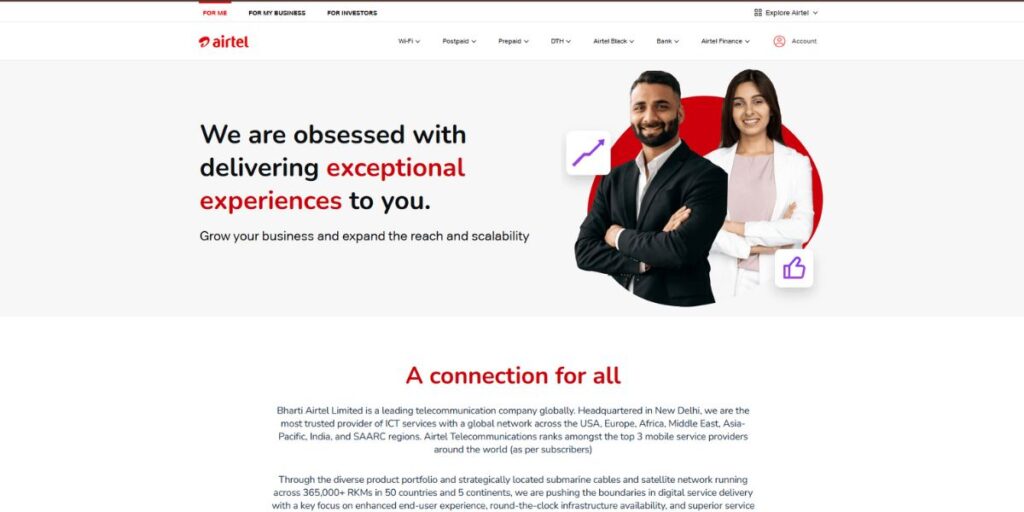Through a transformative process, the telecom business in India has grown increasingly dynamic, and it is one of the most dynamic markets in the world over the last decade. As we travel in 2025, the sector is experiencing an unprecedented growth phase coupled with many advancements and regulatory reform, with a change in the consumer’s pain. Telecom corporations have been the driving force behind this digital revolution in India by supporting the linking of millions of Indians to affordable communication services. In this context of a blossoming country’s digital economy, the telecoms giants have expanded beyond traditional voice solutions to high-speed data, entertainment platforms, Fintech, and enterprise services.
The high level of control among the Indian telecom firms has resulted in some of the world’s cheapest data rates, which have made the digital services affordable to a large population of people and hugely helped in the digital inclusion standards of the country. This article will give the status quo of the Indian Telecom industry, market positions of the top 10 telecom companies in India, and it will talk about other emerging trends which are going to upend the dynamics of the telecom industry as we know it today, and the trends that we will experience in the future.
Understanding the Indian Telecom Sector: A Snapshot in 2025
- Digitalization: The unprecedented growth rate in the usage of digital services has changed the way telecom firms in India do business. Most firms are moving from voice-driven businesses to providing a bundle of services such as entertainment, cloud storage, and financial services to suit the changing needs of consumers.
- Competition: Market consolidation in India, due to intense rivalry among telecom companies, has seen a shift to increasingly fewer players, leaving behind only a few dominant operators that continue to compete aggressively on price, service quality, and value-added services, although in a bid to retain and expand their base.
- Infrastructure: The capital that has flowed into network infrastructure has also been colossal on the part of the leading telecom operators, especially in expanding 5G reach in urban centers and delivering 4G in rural districts, forming a strong backbone for India’s digital economy.
- Rural Penetration: While there is much progress, rural telecom penetration is still a challenge and an opportunity for companies focused on developing special strategies and affordable solutions to bring the unconnected population segments to remote areas of the country.
- Technology Adoption: Acquired capabilities such as AI, IoT, and cloud computing are adopted into key activities of Telecom companies in India to improve customer experience, maximize network operations, and generate new revenue streams beyond conventional connectivity services.
- Tariff Structures: Pricing strategies have matured from purely volume-based strategies to complex models that take usage patterns, value-added services, and premium market offers into account, in line with the maturing market scenario and variety of customer segments.
The Evolving Landscape of Telecom Companies in India
- Market Size: With a market size of about $80 billion by 2025, India has the second-largest telecommunications market, with a number of mobile subscribers beyond 1.2 billion, and broadband penetration in both urban and rural settings continues.
- Mobile Services: This section accounts for approximately 75% of the telecom market, and 4G and 5G are being utilized to fuel revenue growth as consumers increasingly entertain themselves, do commerce, study, and use different digital services on their mobile devices.
- Fixed Broadband: The segment grew significantly since 2023, as fiber connectivity became more available in tier-2 and tier-3 cities. This was due to the COVID-19 remote work trends and consumers’ demand for high-speed, reliable internet for streaming and gaming.
- Enterprise Solutions: Wireless broadband, corporate connectivity services, cloud solutions, and managed networks have become lucrative revenue streams for Indian telecom providers, as many operators are creating their business units to target this fast-growing market niche.
- Regulatory Framework: The telecom regulatory environment has matured, trading off industry growth with consumer protection and tackling issues, such as spectrum sharing, tariffs, quality of service parameters, and data privacy.
- 5G Impact: The national rollout of 5G services has transformed many sectors, including healthcare, manufacturing, agriculture, and education, allowing applications such as telemedicine, industrial automation, precision farming, and immersive learning experiences to come to fruition.
- Government Initiatives: Initiatives such as Digital India, BharatNet, and the Production Linked Incentive (PLI) have played a major role in strengthening the networking capacity of the telecom ecosystem while stimulating local equipment manufacturing, bringing the rural masses into the digital fold, and extending digital literacy to the masses.
Top 10 Telecom Companies in India
1. Reliance Jio

Revenue: ₹92,234 crore (US$11.6 billion) for FY 2023-24
Reliance Jio maintains its leadership in the Indian telecom space two years after becoming a disruptive entrant into the traditional player and becoming a digital ecosystem provider through the commercialization of Reliance Jio 4G in 2025. Among the top telecom companies in India, Jio has rebuilt the telecommunications industry through aggressive pricing, technological innovation, and service diversification since its market entry in 2016. The firm’s strategic thrust towards the development of an integrated digital services platform has had a very strong resonance with Indian consumers across the entire demographic spectrum.
With the umbrella of Reliance Industries, synergies in retail, entertainment, and technology have enabled Jio to become a complete digital household. The company’s strategy of offering affordable connectivity with value-added services has continued to drive subscriber expansion, especially in previously neglected markets.
Key Services Offered:
- Seamless 5G connectivity
- Digital lifestyle apps
- Enterprise cloud solutions
- Fixed wireless access
- IoT ecosystem platforms
Market Position and Subscriber Base:
- Dominates both 4G and 5G network penetration.
- Leading telecom operator in India with over 450 million subscribers
Strengths and USPs:
- All-IP 4G/5G network providing seamless digital experiences.
- Diversified offerings, including JioFiber, JioTV, JioCinema, and JioMeet for a comprehensive digital experience.
Company Details:
- Founded: 2016
- Headquarters: Mumbai, Maharashtra
- Chairman: Akash Ambani
2. Bharti Airtel

Revenue: ₹139,144 crore (US$17.5 billion) for FY 2023-24
Bharti Airtel has successfully rebranded itself as a technology-first telecom operator with no shot of losing its second-mover position as a telecom player in India up until the year 2025. The company’s location preference for network quality and premium service positioning has kept high-value customers within a very competitive market. Airtel has grown to stand out by continually investing in network infrastructure, including the wide dispersion of 5G coverage in urban and semi-urban areas. The strategy of the company in targeting average revenue per user (ARPU) has been a successful agenda in maintaining sustainable growth.
Airtel’s diversification into digital entertainment, cloud services, and cybersecurity solutions has a multi-revenue stream. Its associations with world technology giants and content providers in this regard have enriched its service portfolio, making it one of the most diversified telecom companies in India, having a strong presence in the consumer, enterprise, and home space.
Key Services Offered:
- Premium network experience
- Converged communication solutions
- Home entertainment packages
- Enterprise security services
- International roaming plans
Market Position and Subscriber Base:
- Known for its robust presence in both mobile and broadband services.
- The second-largest operator in India, with over 350 million subscribers.
Strengths and USPs:
- Extensive 4G network coverage across India, with strong enterprise solutions.
- Offers a wide variety of services, including Airtel Xstream, Airtel Thanks, Wynk Music, and Airtel Payments Bank.
Company Details:
- Founded: 1995
- Headquarters: New Delhi Managing
- Director: Gopal Vittal
3. Vodafone Idea (Vi)

Revenue: ₹42,113 crore (US$5.3 billion) for FY 2023-24
In the heels of resolute restructuring and the debt problem solved by late 2023, Vodafone Idea has had a remarkable turnaround in the Indian telecoms market. Among the top telecom companies in India, the firm has positioned itself with a new competitive advantage, re-focusing on network optimization and quality service delivery across its operational territories. Vi has adopted a new differential pricing strategy, which targets different sets of customers and offers competitive tariffs. The company has been able to improve its network ability and service on the backs of the strategic alliances it struck with global technology providers despite financial challenges.
Vi has focused on high-revenue circles while retaining good customer service across the nation. The brand has been able to make a place for itself in the young urban professional world using specific marketing campaigns and special service bundles. By following the synergy of Vodafone Global and Aditya Birla Group, Vi remains one of the key players in the telecom companies list in the Indian landscape, especially dominant in metropolitan and tier-1 cities.
Key Services Offered:
- Flexible prepaid plans
- Business connectivity solutions
- Digital entertainment bundles
- Loyalty rewards program
- International connectivity options
Market Position and Subscriber Base:
- Focused on premium urban segments
- Significant player with a subscriber base of approximately 210 million.
Strengths and USPs:
- Strong 4G network across India, especially in urban areas.
- Customized plans for diverse customer needs, including family packs and unlimited data offers.
- Strategic alliances with global tech companies for enhanced service offerings.
Company Details:
- Founded: 2018 (merger of Vodafone India and Idea Cellular)
- Headquarters: Mumbai, Maharashtra
- CEO: Akshaya Moondra
4. Bharat Sanchar Nigam Limited (BSNL)

Revenue: ₹18,595 crore (US$2.3 billion) for FY 2022-23
As a state-owned telecommunications provider, BSNL has been substantially transformed as far as 2025, turning its previous challenges into opportunities through massive modernization interventions and service realignment. The merger with MTNL and the revival package announced in 2022 have given BSNL a strong market position. Among the oldest telecom companies in India, it has leveraged its extensive fixed-line footprint to grow fiber-to-the-home operations across the country, establishing itself as one of the leading broadband providers. A key advantage for BSNL is its massive rural presence in parts of India underserved by private telecom firms, allowing it to champion the digital inclusion agenda.
The company’s investment in indigenous 4G and 5G is boosting its network capabilities while supporting domestic manufacturing under the “Make in India” initiative. BSNL’s wide focus on government and enterprise clients has resulted in sustained revenue streams that support its consumer business, making operations more sustainable over the long term.
Key Services Offered:
- Extensive rural connectivity
- FTTH broadband services
- Enterprise network solutions
- Satellite phone services
- Government project implementation
Market Position and Subscriber Base:
- Dominant in rural markets
- Over 120 million subscribers (2025).
Strengths and USPs:
- Nationwide infrastructure coverage
- Strong focus on fiber-to-home (FTTH) and broadband services.
- Extensive rural and remote area coverage, bridging the digital divide.
- Strong focus on fiber-to-home (FTTH) and broadband services.
Company Details:
- Founded: 2000
- Headquarters: New Delhi
- Chairman and Managing Director: P.K. Purwar
5. Tata Communications

Revenue in 2025 (TTM): ₹231.89 Billion
By 2025, Tata Communications has positioned itself as a first-rate enterprise-oriented telecommunications company in India, leveraging its worldwide network infrastructure as well as its broad set of business solutions. Whereas consumer-focused telecom companies in India have strategically focused their businesses on multinational corporations, financial institutions, and government establishments, Tata Communications has turned to providing advanced connectivity and digital transformation solutions. The large submarine cable network of the company has been a great enabler in establishing India as a global connectivity hub and in managing a large part of the country’s international internet traffic.
Tata Communications’ early bets on cloud infrastructure, cybersecurity, and IoT infrastructure paid off as enterprise appetite for these services has increased. The company has successfully exploited its affiliation to the Tata Group to generate synergistic offerings across the different industry verticals. Its innovative approach towards delivering services has set new standards for service delivery in the specialized telecoms in India through innovative network operation centers and the development of AI-driven network management solutions.
Key Services Offered:
- Global network solutions
- Cloud connectivity services
- Managed security offerings
- Media transmission networks
- IoT connectivity platforms
Market Position and Subscriber Base:
- Market leader in the enterprise segment
- Strong in B2B markets, with over 100,000 enterprise customers.
Strengths and USPs:
- Global infrastructure backbone
- Expertise in providing global connectivity solutions and cloud-based services.
- Backed by Tata Group, offering credibility and reliability in the market.
Company Details:
- Founded: 1986 (as VSNL, renamed Tata Communications in 2008)
- Headquarters: Mumbai, Maharashtra
- CEO: A.S. Lakshminarayanan
6. Mahanagar Telephone Nigam Limited (MTNL)

Revenue: ₹1,069 crore (US$134 million) for FY 2022-23
MTNL has taken its position stronger over metropolitan markets of Delhi and Mumbai by 2025 after its operational integration with BSNL, while it maintains a separate legal entity. The company has been able to use government support to modernize its infrastructure and diversify its service offerings beyond telephony. MTNL has leveraged the large landed asset base in major urban areas and monetized it in collaboration with respective private telecom companies in India for infrastructure sharing and colocation services. The company’s preference for fixed-line broadband services has thus given positive results, especially within residential complexes and business districts in operational territories.
MTNL has decided to work collaboratively with technology providers in a bid to raise its service delivery capacity with minimal capital investment. Even though the competition from the private sector still challenges it, MTNL has created a sustainable place for itself in the enterprise connectivity market, especially amongst the government departments and public sector undertakings, which ensures its continued existence in the telecommunications industry of India.
Key Services Offered:
- Metropolitan connectivity services
- Government department solutions
- Fiber broadband services
- Fixed telephony networks
- Urban digital infrastructure
Market Position and Subscriber Base:
- Focused on Delhi and Mumbai
- 5+ million total connections
Strengths and USPs:
- Strategic metropolitan presence
Company Details:
- Founded: 1986
- Headquarters: New Delhi
- Chairman and Managing Director: P.K. Purwar (joint leadership with BSNL)
7. Atria Convergence Technologies (ACT Fibernet)

Revenue: ₹2,000 crore (US$250 million) for FY 2022-23
By 2025, ACT Fibernet will have become India’s leading pure-play fibre broadband operator, expanding its footprint beyond the traditional strongholds of the southern part of India to a full national presence. Among the rising top telecom companies in India, ACT has continuously differentiated itself by emphasizing superior connection speed and reliability of service, earning strong customer loyalty in an increasingly competitive market.
The strategic focus on quality over rapid expansion has proven successful for ACT, allowing it to maintain industry-leading customer satisfaction metrics—even in the face of aggressive competition from major telecom companies list in India entering the fixed broadband space. The company has also developed customized connectivity solutions for various customer segments, including gaming-specific plans with optimized routing and enterprise offerings with guaranteed uptime commitments.
Key Services Offered:
- Premium fiber connectivity
- Symmetrical bandwidth plans
- Gaming-optimized connections
- Smart home solutions
- Business fiber services
Market Position and Subscriber Base:
- Leading non-telco ISP
- Subscriber base of over 2 million (2025).
Strengths and USPs:
- Specialized fiber expertise
- High-speed fiber internet with customizable plans for different customer segments.
- Focus on specific segments like gaming plans and enterprise solutions.
Company Details:
- Founded: 2000
- Headquarters: Bangalore, Karnataka
- CEO: Bala Malladi
8. Spectra Broadband

Revenue of Spectra: ₹184Cr as on Mar 31, 2024
Spectra Broadband has carved out a niche as a premium fixed-line internet provider in India’s highly competitive broadband sector. Spectra primarily serves metro cities such as Delhi NCR, Bengaluru, and Mumbai. The company emphasizes consistent high-speed internet with symmetrical upload/download rates and zero data caps on select plans, making it ideal for work-from-home professionals, gamers, and streaming enthusiasts.
Spectra offers tailor-made enterprise and home broadband solutions with advanced network reliability, security, and scalability. The brand has embraced cloud-native infrastructure and next-gen routing to ensure low-latency, buffer-free connectivity. Spectra’s focus on innovation has also led to the development of integrated smart home and IoT-compatible packages.
In a market where large players dominate by scale, Spectra wins through quality, elite service, and a focused presence in high-demand zones.
Key Services Offered:
- Gigabit-speed fiber internet
- Symmetrical upload/download speeds
- Enterprise-grade broadband solutions
- Smart home integration & IoT-ready plans
- 24/7 pro-level customer support
Market Position and Subscriber Base:
- Niche premium broadband provider
- An estimated 700K+ active users in top metros
Strengths and USPs:
- Focus on metro markets with high ARPU (Average Revenue Per User)
- Zero FUP (Fair Usage Policy) on select plans
- Rapid installation & responsive technical support
Company Details:
- Founded: 2000 (as Citycom; rebranded to Spectra in 2017)
- Headquarters: Gurgaon, Haryana
- Service Coverage: Present in 20+ major cities, stronghold in Delhi NCR, Bengaluru, and Mumbai
9. Excitel Broadband

Revenue: Estimated ₹400 crore (US$50 million) for FY 2023-24
Udara will, by 2025, be the value champion in India’s broadband market, delivering affordable fibre connectivity without compromising on essential quality standards. Not limiting its presence to metro cities, the company has expanded into tier-2 and tier-3 regions—areas long underserved by dominant telecom companies in India. Excitel’s innovative partnership model with local cable operators has enabled rapid network growth with minimal capital investment, while fostering entrepreneurship within local communities. With transparent pricing and no hidden charges or unfair usage policies, the company is setting new customer-centric benchmarks in the broadband industry.
The focus that Excitel places on providing high-speed connections with high disruptive sensitivity and high price points has contributed to broadband penetration of price-sensitive segments. The company’s lean operating set up, together with an efficient customer acquisition strategy, has made it profitable, while operating at a lower average revenue per user than premium players, which is a sustainable model for providing mid-market broadband.
Key Services Offered:
- Affordable fiber plans
- Unlimited data options
- No-contract connections
- Multi-device support
- Community WiFi solutions
Market Position and Subscriber Base:
- Value leader in broadband
- 8+ million connections nationwide
- Expanding presence beyond metros to tier-2 and tier-3 cities.
Strengths and USPs:
- Transparent pricing structure
- No FUP (Fair Usage Policy) on its broadband plans.
- Focus on providing high-speed internet with reliable customer support.
Company Details:
- Founded: 2015
- Headquarters: New Delhi
- CEO: Vivek Raina
10. You Broadband (Vodafone Idea subsidiary)

In the Vodafone Idea ecosystem, by 2025, You Broadband has undergone strategic repositioning to target complementary coverage areas and specialized services, effectively expanding Vi’s footprint in the fixed-line segment. While retaining its distinct brand identity, the company has leveraged the technological capabilities and operational expertise of its parent. Rather than nationwide expansion, You Broadband has concentrated on deep service coverage in select urban clusters, ensuring consistent quality. As part of its growth strategy in the competitive landscape of telecom companies in India, it has introduced tailored solutions for small and medium-sized businesses—such as managed WiFi and integrated fixed/mobile connectivity bundles.
The integration of You Broadband with Vi’s billing systems and even customer service infrastructure has led to operational efficiencies and improved customer experience. Although smaller than some other telecom firms in India, You Broadband has created a dedicated customer base by offering personalized services and implementing community outreach programs in the areas it has covered, and has proved that responsive regional-level players are not yet extinct from India’s telecomscape.
Key Services Offered:
- Targeted urban connectivity
- SME business solutions
- Bundled communication packages
- Hybrid network options
- Localized content delivery
Market Position and Subscriber Base:
- Regional-focused operations
- Subscriber base of over 1 million (2025).
Strengths and USPs:
- Personalized service approach
- Known for its reliable, high-speed broadband services.
- Focus on urban markets with fast-growing demand for high-speed internet.
Company Details:
- Founded: 2001
- Headquarters: Mumbai, Maharashtra
- Operating Regions: Presence in 18 cities across 8 states
Emerging Trends Shaping the Indian Telecom Sector in 2025
- Convergence: Telecommunications, entertainment, financial services, and retail domains are increasingly blurring, with telecoms in India becoming digital lifestyle providers with full-blown connected and integrated ecosystems that enable connectivity, content, commerce, and numerous digital services.
- Sustainability: Environmentalism has become a major tenet in telecom operations and has seen companies invest in renewable energy for network infrastructure, investing in e-waste management systems, and deploying technologies that are energy efficient to make their carbon footprint a shade lighter.
- Virtualization: The two technologies — network function virtualization and software-defined networking — have changed the way infrastructure is managed by enabling the operators to minimize the hardware dependency, maximize resource utilization, and utilize the network resources dynamically, considering the real-time demands
- Integration: Artificial intelligence has permeated the surface of core telecom subsystems, such as predictive network maintenance, intelligent customer service bots, personal customer services, and automated fraud detection systems.
- Satellite Connectivity: Low Earth Orbit (LEO) available satellite constellations have come up as an alternative to terrestrial ones, as several telecom companies in India have taken strategic partnerships with the satellite operators to connect the remote and difficult terrain amidst the unavailability of terrestrial ones.
- Edge Computing: The proximity of the deployment of edge computing facilities to end-users has enabled low-latency applications and services to support critical use-cases, for example, for autonomous vehicles, industrial automation, augmented reality, and smart city infrastructure.
The Role of Government and Regulatory Bodies
- Spectrum Management: The Department of Telecommunications has introduced an open and efficient game plan for allocation of spectrum based on balancing the need for revenue generation with desires for more industry growth, so that telecom companies in India are given the necessary exposure to this core asset of theirs to grow their service space.
- Consumer Protection: TRAI has enhanced the consumer protection powerhouses, QoS norms, transparency in billing, and an effective grievance cell to protect consumers firmly.
- Competition Policy: Regulatory frameworks, thus, have developed into a regime of healthy competition to disallow predatory practices, through regulatory mechanisms, the consolidation in the market does not hurt consumer choice or quality of services.
- Indigenous Manufacturing: Government policies have effectively boosted the domestic production of equipment in the telecommunications industry, shielded preferentially from the international market through incentive schemes, preferential access policies, and research and development support, thereby lessening the import profile.
- Digital Inclusion: The relief measures for the USOF have been redesigned to provide newer connectivity in unconnected areas, and public-private partnerships have made it possible for telecom companies in India to expand networks in economically challenging regions.
- Security Standards: Since telecom infrastructure is very important, to prevent networks from cyber threats and uphold national security and data privacy, regulatory bodies have set up elaborate security policies and compliance standards.
Conclusion
The Telecommunications environment in India will eventually reach a very huge tipping point in its growth evolution by 2025 with high levels of technological sophistication, market maturity, and an integrated wider digital economy. The movement of telecom firms in India from mere connectivity providers to pure digital service enablers is a good reflection of the phenomenal flexibility and innovative endowment of the industry.
From the same analysis of the top players, we can also see how each has managed the issue of market position through strategic choices of network investment, service diversification, and customer engagement strategies. The sector continues to be an important component of the digital transformation phenomenon in India, where other industries are reverberating with a revolution. The competitive dynamics in telecom companies in India have opened grand opportunities for consumers who today enjoy world-class digital services at some of the cheapest rates in the world.
READ ALSO:
FAQs
Which is the largest telecom company in India in 2025, in terms of the number of its subscribers?
As of 2025, Reliance Jio accounts for the greatest number of subscribers in all telecom businesses in India, with more than five hundred million active connections between its mobile and fixed broadband services. Its integrated digital ecosystem strategy and cost strategy have been the major drivers for this market leadership position.
What has been the effect of 5G technology on the Indian telecommunications industry?
Widespread deployment of 5G across the nation has moved several industries beyond telecommunications, creating opportunity space for sophisticated applications such as telemedicine, smart farming, industrial automation, and immersive entertainment. For telecom operators, this has created new channels of earning by providing enterprise solutions as well as specialized services, and improving the overall customer experience of retail consumers.
What are the key issues that telecom firms in India are battling?
Telecom operators still face difficulties, such as high spectrum costs, high CAPEX on network improvement, rising competition from over-the-top players, regulatory burden, and balancing affordability with profitability in a price sensitive market despite the positive indicators, such as improvement in subscriber numbers at a keen single digit rate and GSM service almost reaching saturation.
How do Indian telecom companies apply to the rural connectivity needs?
The rural connectivity approaches include infrastructure sharing agreements to de-risk deployment cost, access to Universal Service Obligation Fund subsidies, adoption of alternative technologies such as satellite broadband in the case of remote areas, partnering with local entrepreneurs, and evolution of the specialized low-cost service packages targeting rural consumption patterns.
How to use the role of artificial intelligence in modern telecom operations?
The technologies used by AI are essential to telecom operations, from predictive network maintenance that averts outages to personalisation of customer experience with the help of intelligent recommendation systems, efficient allocation of spectrum automatically, automated customer service with the chatbot capabilities of AI, and sophisticated fraud detection mechanisms to protect revenue streams.

